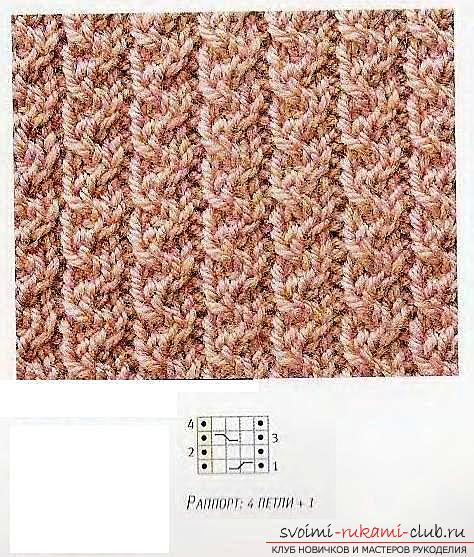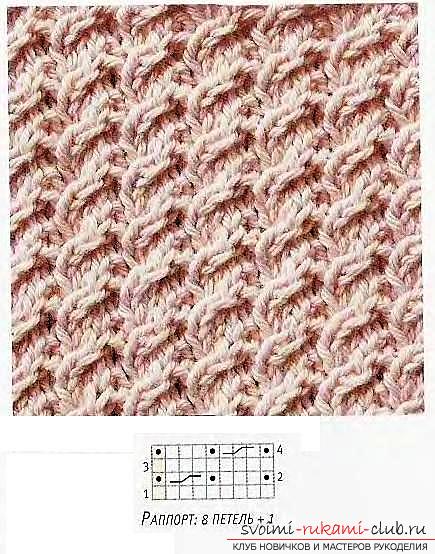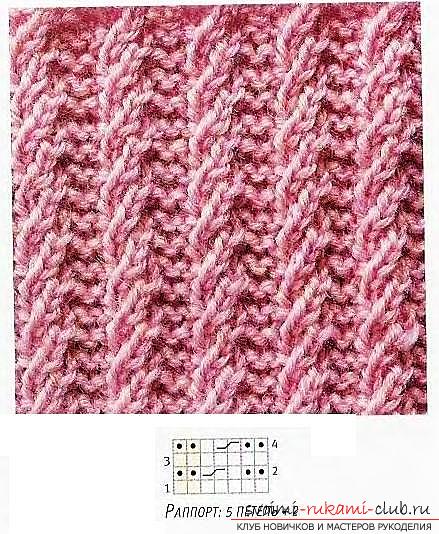
Knit with knitted needles crossed stitches in patterns for making original products with diagrams and detailed description.
Create patterns from crossed loops with knitting needlesThis kind of loops, like crossed, can often be found in combination with the pattern "bundles". Small crossed eyelets are able to hide all the irregularities in the performance of the "bundles". The main advantage of the crossed version of the hinges is undoubtedly the speed of their execution in comparison with the "bundles". In this article, we just in more detail and talk about the specifics of knitting crossed loops and their varieties. Interlacing loops - pattern "Broken Asparagus". When creating such a pattern, it is necessary to perform crossings in the left and right sides. They need to be created on the background of "stocking" knitting.  As a result of the loops that are located in theupper rows, will have greater relief, compared with the lower ones, since they need to be removed without tying in the purl strings. Pattern "Fine mesh". Working with ten loops, this kind of pattern will create a kind of panel consisting of intersecting rhombs.
As a result of the loops that are located in theupper rows, will have greater relief, compared with the lower ones, since they need to be removed without tying in the purl strings. Pattern "Fine mesh". Working with ten loops, this kind of pattern will create a kind of panel consisting of intersecting rhombs.  The pattern of the "Little Spit". This kind of pattern can be used as an interesting analogue of "rubber band". In this case, you should plan a larger number of purlins between the "pigtails", so that this option fully corresponds to the design you have chosen.
The pattern of the "Little Spit". This kind of pattern can be used as an interesting analogue of "rubber band". In this case, you should plan a larger number of purlins between the "pigtails", so that this option fully corresponds to the design you have chosen.  Pattern "Eraser with twigs". A clear advantage of this pattern is its small extensibility, so it can be used as the main one. Wishing to provide one direction of "twigs" pattern, you need to use the initial or final 8 loops of the presented scheme as rapport.
Pattern "Eraser with twigs". A clear advantage of this pattern is its small extensibility, so it can be used as the main one. Wishing to provide one direction of "twigs" pattern, you need to use the initial or final 8 loops of the presented scheme as rapport.  Pattern "Squares of bells". When creating such a pattern, you just need to make a crosshair at the top of all the conventional blocks of the picture to get such an original ornament.
Pattern "Squares of bells". When creating such a pattern, you just need to make a crosshair at the top of all the conventional blocks of the picture to get such an original ornament.  The pattern of "Waves and Crosses". Thanks to the crocheting of knitting, we have the opportunity to create a slight impression of openwork.
The pattern of "Waves and Crosses". Thanks to the crocheting of knitting, we have the opportunity to create a slight impression of openwork.  Pattern "Imitate the tourniquet" Create such a pattern is much easier than it might seem, looking at the photo. To do this, create crosses of 3 loops.
Pattern "Imitate the tourniquet" Create such a pattern is much easier than it might seem, looking at the photo. To do this, create crosses of 3 loops.  Another variation of this pattern: we have the opportunity to create the impression of the pattern "Arana", only the smaller one.
Another variation of this pattern: we have the opportunity to create the impression of the pattern "Arana", only the smaller one.  Pattern "Cross from 2 loops". This pattern looks quite interesting, thanks to simple crosshairs of the loops in the front and the back of the second side.
Pattern "Cross from 2 loops". This pattern looks quite interesting, thanks to simple crosshairs of the loops in the front and the back of the second side.  Pattern "Lattice with removed loops" Toto create such a pattern, it is necessary to tie the 1st and 2nd rows twice, and then we carry out the mating from the 3rd to the 10th row. You also need to double the eleventh and twelfth rows, then tie the thirteenth and twentieth rows, repeating them in the twenty-fourth series. In order for the "grid" to be wider, then it is necessary to repeat the rapport of ten loops, creating 2 additional purlins between the crossings in the 1st row. Then you should move the loops four times to create a rhombus.
Pattern "Lattice with removed loops" Toto create such a pattern, it is necessary to tie the 1st and 2nd rows twice, and then we carry out the mating from the 3rd to the 10th row. You also need to double the eleventh and twelfth rows, then tie the thirteenth and twentieth rows, repeating them in the twenty-fourth series. In order for the "grid" to be wider, then it is necessary to repeat the rapport of ten loops, creating 2 additional purlins between the crossings in the 1st row. Then you should move the loops four times to create a rhombus.  Pattern "Twisted elastic". If you create two twisted loops in all rows, this will make a fairly dense elastic band with a clear contour.
Pattern "Twisted elastic". If you create two twisted loops in all rows, this will make a fairly dense elastic band with a clear contour.  The pattern "Zigzag". Zigzags are executed against a background of stocking with the help of crossed loops. This is done to give extra clarity to the surface of the canvas.
The pattern "Zigzag". Zigzags are executed against a background of stocking with the help of crossed loops. This is done to give extra clarity to the surface of the canvas.  Pattern "Inverted Pyramid". Creating this pattern, you can replace crossed loops on the side of the underside by bundles, but you should remember that it is the crossing of the loops that provides a clear structure of the product.
Pattern "Inverted Pyramid". Creating this pattern, you can replace crossed loops on the side of the underside by bundles, but you should remember that it is the crossing of the loops that provides a clear structure of the product.  Pattern "Diagonal of taken off the loop." If you remove those loops that need to be moved in the previous row, then this will help to extend the loops themselves, and will also give the necessary sharpness to the "diagonals" and "rubber bands" themselves.
Pattern "Diagonal of taken off the loop." If you remove those loops that need to be moved in the previous row, then this will help to extend the loops themselves, and will also give the necessary sharpness to the "diagonals" and "rubber bands" themselves.  Pattern "Oval from the removed loop". If you want to create beautiful curves in your pattern that are similar to oval flagella, then you need to remove the loops in the purl strings. This should be done from the bottom of the crossed loops.
Pattern "Oval from the removed loop". If you want to create beautiful curves in your pattern that are similar to oval flagella, then you need to remove the loops in the purl strings. This should be done from the bottom of the crossed loops.  Pattern "Oak Leaf". This pattern is based on diagonals created from removed loops, which are made in the original structural form with facial and purl loops.
Pattern "Oak Leaf". This pattern is based on diagonals created from removed loops, which are made in the original structural form with facial and purl loops.  The pattern "Bells". Naturally, you can not create a loop horizontally. To do this, you will need to embroider 2 chains of loops, which will be needed in order to finish the bend at the top of the flower stalk. This is necessary after completing the binding of the main pattern. And the other part of the pattern is very simple.
The pattern "Bells". Naturally, you can not create a loop horizontally. To do this, you will need to embroider 2 chains of loops, which will be needed in order to finish the bend at the top of the flower stalk. This is necessary after completing the binding of the main pattern. And the other part of the pattern is very simple.  Pattern "Branching leaves". Adopting the creation of such a pattern, you will certainly notice that it is quite easy to make rapport of twenty rows. The main thing is to make sure that you properly cross the loops in the purl strings.
Pattern "Branching leaves". Adopting the creation of such a pattern, you will certainly notice that it is quite easy to make rapport of twenty rows. The main thing is to make sure that you properly cross the loops in the purl strings. 




